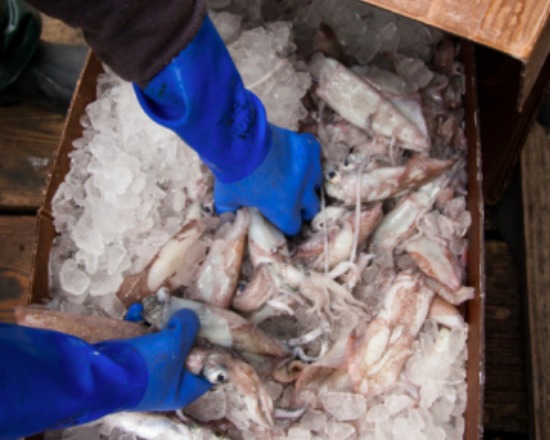
Our Brian Halweil recently joined WNYC’s Amy Eddings on Last Chance Foods to discuss why “squid is the kale of the sea.” He’s written about squid before, including this piece that originally appeared in our March-April 2013 edition.
Incredibly, squid still has an image problem, despite the facts that it’s inexpensive, versatile in the kitchen and “universally popular,” according to some chefs. In fact, squid is among the most local and sustainable seafoods available to New Yorkers.
And, yet, the squid stories in the news track more with sci-fi horror (Godzilla-style radioactive gigantism), or even worse, sci-fi dystopia (Soylent Green–like food items made from things we don’t want to actually eat). So, with prime squid season upon us in Gotham with the lustrous gray bodies on ice at your local Greenmarket and better fishmongers, here’s the skinny on two urban legends that continue to stain the reputation of this tentacled cephalopod we love so much.

Attack of the giant squid. A photo of a monstrous squid went viral last week, inspiring more than 500,000 mentions on Twitter. Said to be caught off the coast of California and allegedly 160 feet long (as big as a 16-story building), the story suggested that the creature had been swimming near the Fukushima nuclear plant and was the result of radioactive gigantism. The hoax was quickly dispelled by National Geographic among others. In fact, there are giant squid like the one in the squid and whale diorama at the American Museum of Natural History; scientists recently used a bioluminescent decoy to capture the first video of the legendary animals here. But even these beasts top out at 55 feet long with eyes as big as basketballs. You will not likely find them on your plate. Longfin squid, the type caught off Long Island, measure a more manageable 8 to 12 inches. Still, squid has gone big in other ways. Red Lobster added it to its appetizers list in the 1980s, where it has held strong for more than three decades. Today, it ranks alongside buffalo wings and jalapeño poppers as “fave app” from Hooters to Applebee’s.
Pig bung calamari isn’t so appetizing, but it’s not real either. Among the most talked about episodes of This American Life is Ben Calhoun’s investigation of sliced pig intestine passed off as calamari. The show is hilarious and fascinating in its depiction of the labyrinthine global food chain in which nothing is wasted, even if it has to be shipped across the ocean to find a willing eater. And while Calhoun describes a taste test in which an eater can’t tell the difference between fried pig bung rings and fried squid rings, the show concludes that pig-bung-mascarading-as-squid doesn’t exist. (And why don’t we give the imposter props for whole-animal butchery?) What’s much more likely is that the squid you get served is from India, Taiwan or China. Even though squid is plentiful in the Northeast, America’s taste for squid has ballooned so much — from virtually nothing in the 1970s to 40,000 tons today — we have to import about 80 percent of the squid we eat. Your safest bet is to seek out whole squid in the market. Or if you are still skeptical, take the advice of Dave Pasternak: “To me, the tentacles are the most important part, the best part.” They’re also harder to fake with pig bung.

The really good news is that there’s an avalanche of fresh New York squid on the menu at all our favorite joints — from the bomboletti at Maialino to the calamari with spicy red sauce at Patsy’s to the charred Montauk squid at Almond Restaurant, whose chef Jason Weiner pulled off a four-course homage to squid last year (ceviche, bibimbap, etc.). And if you ever doubted that squid’s time has come, consider that it’s on the menu twice at Roberta’s right now: as a bar snack in the back and an entrée in the front. One Roberta’s patron, a handsome hipster wearing a “Squid Lips” T-shirt, devoured the squid both ways but had no idea it might be local. He also said the shirt was more for the laughs than to boost squid purchases. No offense taken.
This post originally appeared on Edible East End.



